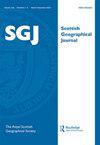2020年8月11日至12日,法夫郡洛蒙德山发生强降雨和泥石流
IF 2
4区 社会学
Q2 GEOGRAPHY
引用次数: 0
摘要
2020年8月11日至12日晚,异常强烈的对流降雨引发了洛蒙德山悬崖上的几次泥石流。本地降雨强度超过估计的年超出概率0.33%。每次泥石流都有不同的大小和物理特征,这取决于水和沉积物的可用性以及植被缓冲带的有效性,因此外观相似的微集水区以不同的方式作出反应。其中最大的泥石流震级远超其他泥石流,延伸1公里多,下降246米,估计体积约1500-3000立方米,对一条林道造成破坏。残骸来自于一个有沟壑的残垣,包括倒下的树木和冰川冰川河流沙的切口。沉积物沉积学和形态学表明,最初的泥石流浪涌可能发生在风暴早期,与最大的产流相吻合,随后是河流切割和沉积物改造。这似乎是洛蒙德山90多年来最大的此类事件,可能是对21世纪夏季对流降雨强度预计增加的景观响应的特征。本文章由计算机程序翻译,如有差异,请以英文原文为准。
Intense rainfall and debris flows in the Lomond Hills, Fife, 11–12 August 2020
ABSTRACT Over the night of 11–12th August 2020, unusually intense convective rainfall triggered several debris flows along the Lomond Hills escarpment. Rainfall intensities locally exceeded an estimated 0.33% annual exceedance probability. Each debris flow had a different magnitude and physical character depending on the availability of water and sediment and the effectiveness of the vegetation buffer, such that similar-looking micro-catchments responded in different ways. The largest debris flow far exceeded the others in magnitude, extending over 1 km with a descent of 246 m and an estimated volume of c. 1500–3000 m3, causing damage to a forestry road. Debris was entrained from a gullied relict talus, including fallen trees and incision of Lateglacial glaciofluvial sand. Deposit sedimentology and morphology demonstrate an initial debris-flow surge probably happened early in the storm coinciding with the greatest runoff generation, followed by later fluvial incision and sediment reworking. This appears to be the largest such event in the Lomond Hills for more than 90 years and may be characteristic of the landscape response to projected increases in convective rainfall intensities in twenty-first century summers.
求助全文
通过发布文献求助,成功后即可免费获取论文全文。
去求助
来源期刊

Scottish Geographical Journal
GEOGRAPHY-
CiteScore
1.80
自引率
20.00%
发文量
19
期刊介绍:
The Scottish Geographical Journal is the learned publication of the Royal Scottish Geographical Society and is a continuation of the Scottish Geographical Magazine, first published in 1885. The Journal was relaunched in its present format in 1999. The Journal is international in outlook and publishes scholarly articles of original research from any branch of geography and on any part of the world, while at the same time maintaining a distinctive interest in and concern with issues relating to Scotland. “The Scottish Geographical Journal mixes physical and human geography in a way that no other international journal does. It deploys a long heritage of geography in Scotland to address the most pressing issues of today."
 求助内容:
求助内容: 应助结果提醒方式:
应助结果提醒方式:


